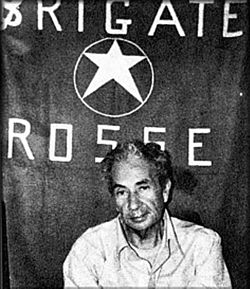
Back Operació Fritz Catalan Απαγωγή και δολοφονία του Άλντο Μόρο Greek Enlèvement et assassinat d'Aldo Moro French Caso Moro Italian 알도 모로 납치 사건 Korean Porwanie Alda Moro Polish Похищение и убийство Альдо Моро Russian
| Kidnapping and murder of Aldo Moro | |
|---|---|
| Part of the Years of Lead | |
 Moro during his imprisonment | |
| Location | Rome, Italy |
| Date | 16 March 1978 – 9 May 1978 |
Attack type | |
| Deaths | 6 (Aldo Moro and 5 bodyguards) |
| Perpetrators | Red Brigades |
The kidnapping and murder of Aldo Moro, also referred to in Italy as the Moro case (Italian: caso Moro), was a seminal event in Italian political history. On the morning of 16 March 1978, the day on which a new cabinet led by Giulio Andreotti was to have undergone a confidence vote in the Italian Parliament, the car of Aldo Moro, former prime minister and then president of the Christian Democracy party (Italian: Democrazia Cristiana, or DC, Italy's relative majority party at the time), was assaulted by a group of far-left terrorists known as the Red Brigades (Italian: Brigate Rosse, or BR) in via Fani in Rome. Firing automatic weapons, the terrorists killed Moro's bodyguards — two Carabinieri in Moro's car and three policemen in the following car — and kidnapped him. The events remain a national trauma.[1][2] Ezio Mauro of La Repubblica described the events as Italy's 9/11.[3] While Italy was not the sole European country to experience extremist terrorism, which also occurred in France, Germany, Ireland, and Spain,[4] the murder of Moro was the apogee of Italy's Years of Lead.[3]
On 9 May 1978, Moro's body was found in the boot of a Renault 4 in via Caetani after 54 days of imprisonment. Moro had been subjected to a political trial by a "people's court" set up by the BR, which had asked the Italian government for an exchange of prisoners. The car with Moro's body was found very close to both locations of the national offices of the DC and the Italian Communist Party (Italian: Partito Comunista Italiano, or PCI, the largest Communist party of Western Europe) in Rome.[5] The BR were opposed to Moro and the PCI's Historic Compromise.[6][7] On 23 January 1983, an Italian court sentenced 32 members of the BR to life imprisonment for their role in the kidnapping and murder of Moro, among other crimes.[8] Many elements and facts have never been fully cleared up,[9][10] despite a series of trials,[11] and this has led to the promotion of a number of alternative theories about the events,[3] including conspiracy theories.[11]
- ^ "Halo for Italy's martyred PM, friend of Paul VI seems on hold". Crux. 17 April 2021. Retrieved 7 August 2023.
- ^ Benraad, Myriam (19 April 2023). "'Esterno Notte': Marco Bellochio's series grapples with ghost of assassinated Italian prime minister Aldo Moro". The Conversation. Retrieved 7 August 2023.
- ^ a b c Iovene, Franck (15 March 2018). "Remembering Aldo Moro, the former prime minister killed by terrorists during Italy's 'Years of Lead'". The Local. Archived from the original on 7 August 2023. Retrieved 7 August 2023.
- ^ Canario, Massimo (9 May 2022). "The kidnapping and killing of Aldo Moro". Europeana.eu. Retrieved 7 August 2023.
- ^ Fasanella, Giovanni; Roca, Giuseppe (2003). Il misterioso intermediario: Igorʹ Markevič e il caso Moro [The Mysterious Intermediary: Igor Markevitch and the Moro Affair]. Einaudi.
- ^ Broder, David (9 May 2018). "Historically Compromised". Jacobin. Retrieved 6 August 2023.
- ^ Castro, Beppe (14 September 2022). "The Kidnapping And Murder Of Aldo Moro". Saturdays In Rome. Retrieved 7 August 2023.
The Red Brigades believed that the success of the kidnapping would stop the Communists' rise to become integrated into Italian state institutions and as such being part of the machine they viewed as corrupt and oppressive. Without the [PCI] being part of the government, the Red Brigades could continue with their revolutionary war against capitalism. In the first communication by the Red Brigades, they claimed that the DC: '... had been suppressing the Italian people for years'.
- ^ "Moro's killers among 32 jailed for life in Italy". The New York Times. 25 January 1983. p. 3. Retrieved 7 August 2023.
- ^ Sadurní, J. M. (8 May 2022). "L'omicidio di Aldo Moro". Storica (in Italian). Retrieved 9 September 2023.
- ^ Sagerson, Andrew (9 May 2023). "The kidnapping and assassination of Aldo Moro". Wanted in Rome. Retrieved 11 August 2023.
- ^ a b Drake, Richard (2001). "Why the Moro Trials Have Not Settled the Moro Murder Case: A Problem in Political and Intellectual History". The Journal of Modern History. 73 (2): 359–378. doi:10.1086/321029. ISSN 0022-2801. JSTOR 10.1086/321029. S2CID 144245156.